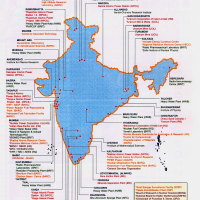[Investigation] The Great Fertiliser Robbery
 Photo: AFP
Photo: AFP
Every year, the government spends anywhere between Rs 70,000-Rs 90,000 crore in subsidies to ensure affordable fertilisers for farmers to enable them to get a good yield. Yet, curiously, foodgrain production has not seen much increase, while farmers still continue to complain about unaffordable fertilisers.
In October 2012, TEHELKA had shown how flaws in the government’s pricing policy were letting private players increase fertiliser prices and siphon off subsidies (This Is Why Farmers Can’t Afford Fertilisers by G Vishnu, 1 October). An ongoing investigation by the Director General of Central Excise Intelligence (DGCEI) has now revealed the extent of the scam; how it has spread on a massive scale in the three states of Gujarat, Maharashtra and Haryana. TEHELKA has access to exclusive information that the DGCEI is probing alleged evasion of excise duty by more than 50 big companies.
Officials detail how over the past five years, these business houses siphoned off 10 million metric tonnes (MT) of agriculture-grade urea for which the government had paid more than Rs 2,000 crore as subsidy. Despite having annual turnovers of over Rs 200 crore, these companies also avoided paying more than Rs 300 crore in excise duties to the government in the same period.
Fertilisers are essential to a successful agricultural yield. Over two decades now, the Government of India has been subsidising fertilisers with the aim of easing the burden on farmers. Among the various fertiliser combinations, urea is one of the most utilised. Whereas India produces up to 22 million MT of urea annually, close to 8 million MT is imported. For every tonne produced, the government reimburses the difference between the cost of production and the MRP. Currently, urea is sold at Rs 5,360 per MT ( Rs 5.36 per kilo) and the subsidy ranges between Rs 9,000- Rs 20,000 per MT. Industries that manufacture dyes, colouring agents, resins, plywood, etc, use technical-grade urea, which is priced at Rs 32 per kg (Rs 32,000 per tonne). The government subsidy, however, is only meant for urea used for agriculture and not industrial purposes.
The DGCEI probe, which started as an investigation into the excise duty evasion by manufacturers of CPC Blue (a pigmentation agent that adds colour to paints), also discovered that private players were diverting the urea meant for farming to their own godowns. On top of that, over the past five years, these companies had evaded excise duty in excess of Rs 300 crore by concealing the purchase of urea.
How they did this is a reflection of how deep the rot is. A DGCEI investigating officer describes the situation as “an economy, kind of like a cottage industry, especially in Gujarat. A well-oiled system is in place to facilitate diversion of urea to these companies”. The DGCEI found that in the past five years, two lakh MT of urea has been diverted in Maharashtra and 20,000 MT in Haryana, while around 10 lakh MT has been diverted in Gujarat alone.
Among the many companies who benefited from subsidised urea are big names that include Asahi Songwon (owner Paru Jaykrishna was president of the Gujarat Chamber of Commerce in 2007-08), Phthalo Color (owned by the Nanavati Group that also owns the Nanavati Hospital in Mumbai), Meghmani Organics, Narayan Industries and Narayan Organic, Heubach Intermediates and Ramdev Chemicals in Gujarat. Mazda Colours and Shreyas Intermediates in Maharashtra and Bhabani Pigments in Haryana have also illegally diverted the agriculture- grade urea for their purposes — consequently saving on importing technical -grade urea and paying the customs duty.
These companies — most of them based in Gujarat — would buy urea from ‘trading companies’ such as Karan Chemicals, Lakshya Ventures and Lakshmi Enterprises, who, in turn, would provide fake bills showing purchase of salt. Interestingly, salt is not required at any stage in the production of CPC Blue. Yet, on record, the 50-odd companies had bought 10 lakh MT of salt. For instance, Karan Chemicals, one of the trading companies, has 10 dummy firms that claim to be selling salts to these companies. “They have followed every trick in the book to pull off this scam,” says a dgcei official, showing TEHELKA bills for non-existent mountains of salt.
This fact comes straight from the horse’s mouth. In a written statement to the DGCEI, Piyush Patel, president of CPC Blue Manufacturers’ Association and owner of Ishan Chemicals, has admitted that his own company indulged in this illegal practice.
“So far as the purchase of salt is concerned,” reads a statement by Piyush’s son Shrinal Patel, also director of Ishan Dyes and Chemicals Ltd, “according to the market strategy, we are procuring urea in the guise of salt under the invoices for salt… However, under the compulsion of market strategy and to remain in competition, we had to adopt this way.” Patel’s views are similar to what others who have appeared before the DGCEI probe committee have said.
Distribution of urea comes under the ambit of the state government. Once the Department of Fertilisers (DoF) at the Centre decides on the allocation for states, it is the state agricultural departments’ job to ensure distribution to farmers. This is where the village-level Agriculture Business Centres (ABCs) come into play. These local-level agencies that connect with the farmer play a massive role in giving out fake bills to the Department of Agriculture (DoA) in the name of non-existent farmers. Till now, the DGCEI has raided over 15 ABCs in Gujarat, all of which were found handing out fake bills.
“What we found was simply by carrying out raids and scrutinising documents,” says a DGCEI investigating officer. “It is not possible that the state DoA does not know about these practices. Convenient arrangements have been struck between politicians, bureaucrats and these business houses.”
Little surprise then, that in 2011, the Gujarat government kept demanding more and more urea, even though the state was seeing a drought-like situation. Since 2006, Gujarat has been complaining about urea shortage, at times asking Union Minister of Agriculture Sharad Pawar to step in. The DGCEI is investigating the probable involvement of some of the cooperatives that manufacture urea in Gujarat such as the Krishak Bharati Cooperative Limited (KRIBHCO), Gujarat Narmada Valley Fertilisers Company Ltd (GNFC), Gujarat State Fertiliser & Chemicals Ltd (GSFC) and the Indian Farmers Fertiliser Cooperative Limited (IFFCO).
“Right now, we are probing the 50- odd CPC Blue manufacturing companies under the Customs Act,” says another DGCEI official on condition of anonymity. “The Centre has not shown enough grit to crack down on these practices. If the CBI is to come into the picture tomorrow, all these companies will be charged under the Essential Commodities Act and they can be held criminally accountable.”
Repeated attempts by TEHELKA to get these companies to respond were met with silence. The few who chose to say anything, like Bhabani Pigments and Narayan Organics, declined any wrong-doing on their part. Interestingly though, Shrinal Patel of Ishan Dyes and Chemicals had a different explanation.
“We get the product,” says Patel, “and test it in our lab. If a product works for me, I purchase it. I haven’t bought it from any authorised agency. We have been telling the Central government that we are willing to purchase it at any price, but our condition was that it should be made available locally. On import, the particle size of technical-grade urea is coated with nitrogen on the outside, causing loss, but the government did not accept it.”
That the government has been complicit in the unchecked diversion of fertilisers meant for the poor, gains currency from the DGCEI’s own findings. “Government agencies have played a major role in all this,” says a DGCEI official. “Till now, we have found excise evasion of 300 crore. The diversion of over 10 lakh MT of urea that we have found was from just CPC Blue manufacturers. All we had to do was figure out the scientific formula behind manufacturing CPC Blue — salt does not come anywhere in the process. If we are to figure out the formula for other industries that manufacture resins, plywood, paints and dyes, we should be able to make a complete crackdown on diversion.”
Despite the fact that, since September 2012, the Centre has set up teams in the 17 states to put a check on this practice. Even as recently as 14 March, the Chemical and Fertilisers Secretary Sudhir Mittal wrote to the states, urging them to set up a mechanism to curb diversion.
So, why has nothing happened? Officials in the DoF at the Centre blame the states for lack of transparency, negligence and unwillingness towards bringing diversion and black marketing to a halt.
“Our pricing policy is yet to be implemented,” says an official with the DoF in New Delhi. “Fertiliser prices have been skyrocketing for the past three years, increasing as much as five times in some cases. On the ground, this has resulted in the farmer using a single fertiliser to such an extent that the soil loses value in some years. This has been disastrous for Indian agriculture.”
A senior official at the Ministry of Chemicals and Fertilisers explains how the powerful fertiliser lobby has manipulated the situation to its advantage. “Most politicians do not antagonise this lobby,” he says. “No matter how hard you try to stonewall them, they still find a way to reach you.” The official cites a recent incident, when members of the fertiliser lobby made a presentation in a group of ministers (GoM) meeting much to the surprise of some ministers, who had managed to keep the private players away from influencing policy decisions. Other officials even recall instances when chief ministers have stepped in to stop probes.
These players have such a stranglehold on the sector that in the past three months alone, the ministry has spent Rs 300 crore excess while procuring.
“Around February every year, the DoF determines the quantum of fertilisers needed for the year and the procurement is planned,” says an official working for a PSU that produces fertilisers. “This year too, Indian Potash Limited (IPL, a conglomerate that started as a PSU, but is currently an amalgamation of cooperatives) was given the charge of importing 10 lakh MT of urea. But the ministry cleared only five lakh MT for import. IPL imported the same for $385 per MT in May. By June, when state-owned PSU MMTC placed tenders, the price of urea was $335. By 22 June, when the state-owned STC issued the tender, the price fell to $303. Being a private player, IPL understands the market fluctuations well, but it earned a lot in commissions by placing the order in May. The loss to the government for not giving the charge of import to a PSU was Rs 300 crore.”
Incidentally, the CAG had pulled up IPL in 2011 for getting undue benefits to the tune of Rs 762 crore after fudging its tenders. The explosive CAG report had raised expectations in some ministry circles that wanted to bring reforms and transparency. However, as the recent loss shows, the stranglehold is yet to loosen.
Amidst all this, the Indian farmer continues to lose out, as it is his fertilisers that are getting diverted and hoarded, while he has to buy it at a higher price. In a year when the total amount of subsidy spent on fertilisers touched a whopping Rs 90,000 crore, his fields benefit minimally and he is left wondering where the promised subsidy goes.
(Published in Tehelka Magazine, Volume 10 Issue 27, Dated 6 July 2013)



















